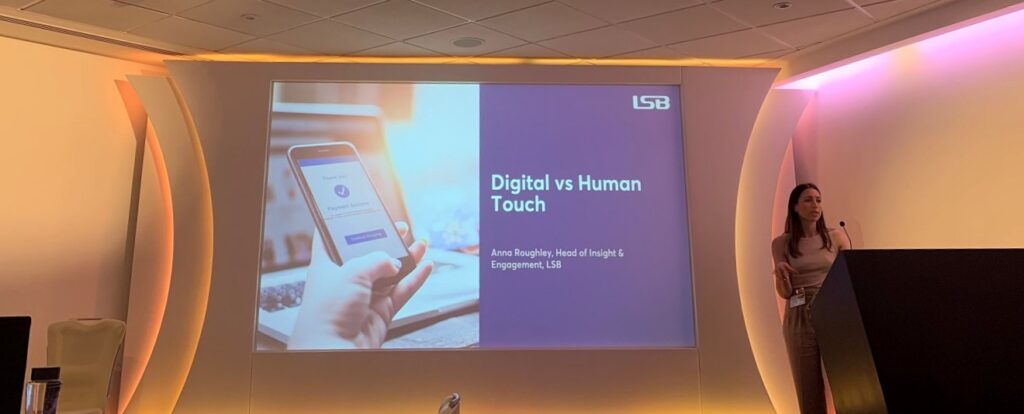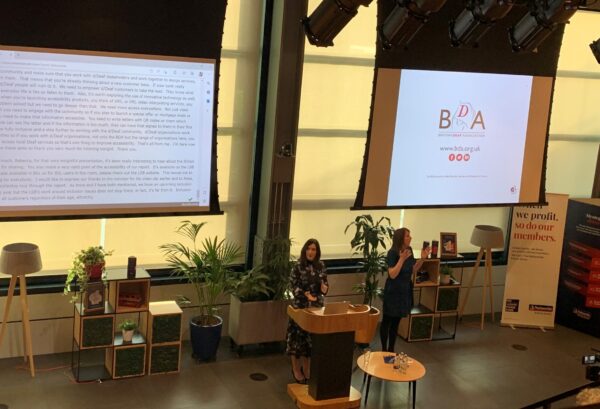LSB Head of Insight & Engagement, Anna Roughley, recently spoke at the 10th Annual Financial Services Customer Experience Conference on how financial services firms can deliver better customer outcomes amidst an increasingly challenging financial landscape and strike a balance between inclusion and digital progression.

*The notes below may differ from those delivered on the day*
Good afternoon, and thank you for having me here today. My name is Anna Roughley and I’m the Head of Insight and Engagement at the Lending Standards Board – the LSB. I’m sure you’ll agree we’ve heard from a really exciting range of speakers today on how to ensure an outcomes focussed approach for customers in the financial services industry. To ensure I give you as much insight as possible over the next 15 minutes, I’m going to focus on the evolution of digital and traditional services, the importance of financial inclusion in all we do, and practically, how to ensure no customer is left behind through inclusive design, timing, training, raising awareness, and effective communication. Before I start, I thought it’d be useful to tell you a bit about the LSB, and why we have been invited to speak to you today on this topic.
For those who don’t know, the LSB is the primary self-regulatory body for the banking and lending industry, driving fair outcomes for customers. What that means is we set and oversee best practice standards and codes that sit atop statutory regulation, or exist where there is no current regulation in place. Our Standards are outcomes focussed. Banks, lenders and building societies that sign up to adhere to them – meaning they are subject to our oversight, do so not just to do the right thing by their customers, but to set the bar high and give them the best possible outcome.
The Standards provide protections for personal customers, business customers with a turnover of up to 25 million, and put in place much needed protections for customers against Authorised Push Payment scams. The Standards were designed with all channels in mind, and so apply to traditional banks and lenders, through to fintechs and digital providers. It’s through our oversight work and engagement with firms that we see and hear first-hand areas of emerging risk, areas of good practice, and areas where development is needed in relation to customer outcomes. From this we develop insights and practical considerations for firms to help them deliver the best outcomes for all customers. I’m going to share some of those insights with you today and hopefully they will be something you can take away with you and utilise. Before I do that though, I’d like to take a moment to set the scene, and look at how we got here, and why conversations like this are so important.
How did we get here?
When I was little, I’d sometimes join my nan when she went to the bank. I have clear memories of her using the pen on the chain at the kiosk to pay a bill or send money to a friend, and she’d always take a withdrawal slip home for me to play with – pretending I was a banker. Did I ever expect that a certain number of years later, I’d make the same type of payments as my nan, but from my living room sofa at the click of a button, and it’d take minutes, seconds even? Not really.
The kiosk at a bank still exists for some, but it feels like a far rarer experience than the digital journey. I want to stress here that both of these scenarios exist today, and rightly so, because they both have a place in the industry.
There’s been a mass acceleration of digital products and services in recent years, which isn’t surprising due to the ever-growing industry, external factors like the pandemic fuelling our engagement online, and new generations growing up with technology as the norm and many others seeing its benefits and turning to it for their everyday needs. For a large cohort of customers, accessing banking services from their phone or laptop is ideal – more than ideal – it’s desirable. It’s quick, convenient and suits their needs. But that isn’t the case for everyone. For customers not confident using technology, for customers who can’t use technology because it’s inaccessible for them, for customers who need that human touch of speaking to someone face to face, digital banking services aren’t, and might never be, suitable for them, and that is why traditional services are still important. But in saying that traditional banking channels still have a place in the industry, I’m not saying they don’t need to adapt too, because they do, and there are good examples of where they have adapted. I’ll come on to some of those examples shortly.
So as digital advancements continue to evolve and grow, and customer needs continue to adapt, as they have and always will do, so the banking and lending industry must also adapt to keep pace with the change, whilst ensuring that good customer outcomes don’t waiver as a result.
The evolution of customer needs
As we are acutely aware, the pandemic, Brexit, the war on Ukraine, and the cost-of-living crisis are causing mass uncertainty, instability and challenges across the country for individuals and businesses. As the landscape evolves, so do customer’s needs. This is not a new thing though. Each customer is an individual and should be treated as one. As individuals, we all have differing needs, and those needs evolve over time. Sure, external factors like the ones I’ve just mentioned can cause bigger shifts in customer circumstances, but those differing needs have always been there, we are just becoming more aware of them now. And there won’t always be a straightforward solution to how you meet those needs. But this isn’t always about having the exact answer every time, but instead having the flexibility to treat each customer as an individual, asking them what they need, and catering where possible to that. This is financial inclusion. Ensuring that everyone, no matter what their life experiences or circumstances are, or how they choose to conduct their banking, can access what they need, when they need it.
How digital and traditional services have evolved
Branch access looks very different now to what it used to. Banking hubs, for one, are an innovative way of maintaining access to cash and that face-to-face point of contact in local communities. These hubs provide a shared service with numerous banks coming together to allow customers to carry out their financial needs, face-to-face with someone from the post office or their bank. It’s an accessible way of filling the gaps left by branch closures, and ensuring that human touch for those who need it.
What banks and lenders must consider is how to maintain the buy in from customers who typically used branches for their banking needs. They have to put themselves in the customers’ shoes and think – what do they want this experience to look like and how can we cater to that? Do they trust that the service we will be providing here – bearing in mind it’s being provided alongside a number of other banks and often by post office staff – is in line with their usual banking experience – if not, how can we feed through our messaging, our brand, our usual customer interaction to help them get the best and most comfortable experience?
Within digital channels, as I mentioned, there are many opportunities for customers, but there are also risks too. As an example, we recently conducted a thematic review of our registered firms’ vulnerability practices across our Standards and Codes. We found that within digital channels, firms had less opportunities to identify customer vulnerabilities due to systems not currently allowing this to occur easily. The challenge here for firms now lies in how to identify vulnerability and additional support needs throughout the digital journey, without those human touch points where this may naturally come up in conversation, whilst at the same time, not adding too much friction into what should be a highly automated process.
Practical tips for ensuring inclusivity
I want to acknowledge that firms are under pressure right now, arguably more so than ever, with regulation requirements growing, and with the pressure they’re putting on themselves to do the right thing. That is the purpose of organisations like the Lending Standards Board – to provide best practice guidance for firms, to hold them accountable to stay on that right track, and to provide greater insights into the industry so firms can identify emerging risks and be prepared for them.
I thought might be helpful now with the time we have left, is to look at one case study example, highlighting the risks, in a digital journey in this case and how firms can ensure that their customers get a good outcome. And so, here are the top five practical steps that can be taken to make a demonstrable impact on how you achieve financial inclusivity for your customers – inclusive design, timing, training, raising awareness, and effective communication. In the case study that I’m going to share, I have taken the example of a firm who is automating its application process. The firm has decided that all applications will now be processed digitally. However, they also want to ensure that the new process is inclusive for all customers. So, what do they need to consider here?
Inclusive design
Well, the first thing to consider is how the new service will be designed. If the firm only sets out to achieve a new digitalised application process, and does not actually make inclusivity a project objective, then there is a risk the changes being made will leave some customers behind, for example, those who can’t or don’t want to engage digitally. However, if the firm adopts an inclusive design process, they will have a higher chance of designing the new service in a way that works for all customers. This is something that has been made clear to us at the LSB. We’ve recently published the second report in our new inclusion series, which has so far looked into inclusivity for disabled business customers and those with access needs, and access for the d/Deaf community. As part of our research and work in this space, we have found that having a design process that is inclusive and promotes accessibility is central to offering more open products and services.
What does this look like in practice? Well, most firms have a formalised product design process. But they haven’t thought about or critically assessed who is involved in their process, checking that there is a selection of diverse viewpoints being used to assess risks and opportunities. Essentially – don’t underestimate the value of lived experience. By using the skills and experiences of existing staff, and creating a culture where staff feel able to disclose and share their lived experience if they want to, you can help to raise awareness of different challenges customers may face and how to support them. For example, including people who aren’t tech savvy, people who are tech savvy, people of different ages, backgrounds, religions, ethnicities, abilities, and disabilities – giving a diverse group of people a seat at the table, and importantly a voice, can help to ensure that a product or service caters for the masses, not just a few.
We recently came across a prime example of why lived experience is so vital when it comes to designing a service, that I’d like to share with you today. This particular example came from the Deaf community. Now you might assume that for this community, over the phone contact from a bank is not a suitable method of contact, and therefore communicating via letters or email may instead be more suitable – not necessarily. We learnt through our work with other organisations that British Sign Language does not actually translate to plain English when written, and therefore a letter received in plain English, may not actually be accessible for a member of the deaf community to read. This is why lived experience is so vital.
In the case study on the screen, you can see an example of firms using inclusive design well. In this example, the firm developed a working group including people with lived experience who were able to identify where the new app they were transitioning to may be inaccessible for some customers. From this, they were able to adapt their design so that customers at risk of being excluded were still able to engage with and use the services on offer.
Timing
The second top practical tip is timing – simply, giving customers the time they need. Overwhelmingly the research we have conducted around inclusivity showed us that firms impose time restrictions on customers in terms of completing forms and applications, but it was clear that for some customers, they need more time to complete these steps. This is because some customers will require assistance from others to complete applications, or need somebody to sit next to them whilst they complete forms. This can come across as bizarre or strange to those who don’t need that support, but making this change and allowing customers to take the time they require to complete their banking is likely to result in higher quality information being provided, and will help ensure that the customer can access the products they need.
In the case study I have shared, you can see an example of the firm integrating more time into their new process, to avoid excluding or disadvantaging those customers who might need longer for their application.
Training
Moving onto number three – training. Now I know what you’re thinking – ‘Anna, we know training is important, this is nothing new’, but bear with me!
We have found through our work that a large number of firms have made steps in terms of making accessing their lenders online, in branch and over the phone more accessible. However, most fall over because they have not properly trained their staff in what options are available, how to access them, and how then to use them. This meant that the accessible tools were, in reality, inaccessible, because nobody know how to provide them. This is such a great example of why the right training is so important. Effective training around inclusion promotes a culture of understanding and open-mindedness, where staff understand customers may interact differently for a whole variety of reasons. Training also prepares staff to look out for opportunities to offer support, in a way that gives them confidence to do the right thing. It should be delivered in a timely way so change can be proactive and effective immediately.
In the example in our case study, the firm in question upskilled and trained its staff on how the app had been designed for customers and what the benefits of using it are, so they feel confident in supporting customers to move over to this digital service.
Raising awareness
The fourth step is raising awareness. What we’re not saying is firms need to be experts in every difficult factor a customer may face, but equipping staff with information and understanding on the various ways people may experience vulnerabilities or difficulties can make a big difference in how a service is delivered. This is again where sharing lived experience comes in very handy.
In our case study, you can see that the firm ensured its staff have a rounded understanding of different access needs. This allows everyone to have a clearer picture of how using the new app may feel daunting for some customers, but how those challenges have been considered and mitigated to ensure all customers are able to use the digital service.
Effective communication
The fifth change I want to touch on is about communication, and how that it seems for some staff, a fear of causing offence could lead to a hesitation to act. This can be a particular challenge when engaging through digital services, as tone, verbal nods and facial expressions cannot be used to help aid the conversation. For example, if an adviser identifies through an email or chat service that a banking customer may have a disability or access need, but does not offer any support out of fear of using the wrong words or phrases, this could lead to a bad outcome.
There is definitely a balance to strike here. On the one hand, using outdated language could deter customers from making contact or applications, accessing support or might even cause offence. That being said, the worst thing that could happen is a lack of action as a result of being concerned about how to communicate.
In the case study, you can see an example of the firm adapting the way it communicates with customers through the app in order to ensure they understand and can utilise the support that is available to them. This is essential because well intentioned services alone will not ensure inclusivity; instead, it is crucial that customers truly understand how you want to and will support them.
These are just a few examples of how banks and lenders can ensure their offerings, regardless of the channel they are delivered through, are suitable and accessible for their customer base.
By introducing simple but impactful changes – looking at what you already have in place, tailoring it to your customer’s needs and constantly reviewing and improving, you can ensure your customers get a fair deal.









